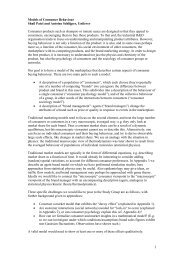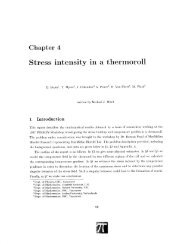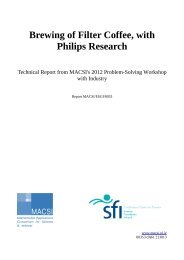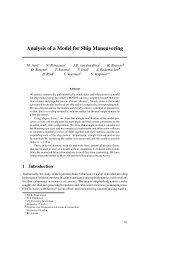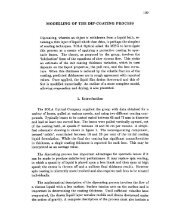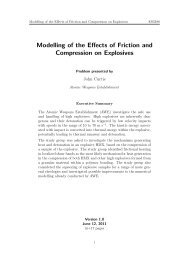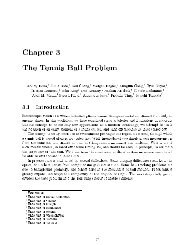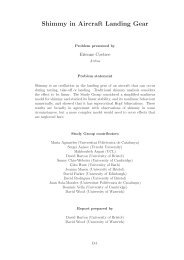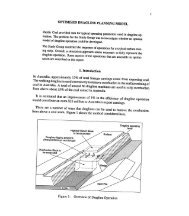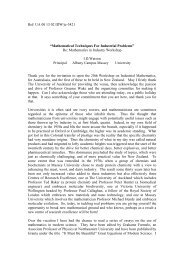Strip Temperature in a metal coating line annealing furnace New ...
Strip Temperature in a metal coating line annealing furnace New ...
Strip Temperature in a metal coating line annealing furnace New ...
You also want an ePaper? Increase the reach of your titles
YUMPU automatically turns print PDFs into web optimized ePapers that Google loves.
<strong>Strip</strong> <strong>Temperature</strong> <strong>in</strong> a <strong>metal</strong> coat<strong>in</strong>g l<strong>in</strong>e<br />
anneal<strong>in</strong>g <strong>furnace</strong><br />
<strong>New</strong> Zealand Steel<br />
Industry Representatives:<br />
Philip Bagshaw, Manager Product Technology, <strong>New</strong> Zealand Steel<br />
Nebojsa Joveljic, Pr<strong>in</strong>cipal Technologist, <strong>New</strong> Zealand Steel<br />
Damien J<strong>in</strong>ks, Research Scientist, Bluescope Steel Research, Australia<br />
Michael O’Connor, Senior Process Control Eng<strong>in</strong>eer, <strong>New</strong> Zealand Steel<br />
Moderators:<br />
Robert McKibb<strong>in</strong>, Massey University at Albany, Auckland<br />
Andy Wilk<strong>in</strong>s, Canesis, Christchurch<br />
<strong>New</strong> Zealand Steel (NZS) use a unique process to convert <strong>New</strong> Zealand<br />
iron-sand <strong>in</strong>to steel sheet products at its Glenbrook mill near Auckland.<br />
Traditional galvanised steel (Galvsteel TM ) and the new product<br />
Z<strong>in</strong>calume Λ are produced <strong>in</strong> arange of dimensions, grades and coat<strong>in</strong>g<br />
weights.<br />
The steel strip is annealed prior to be<strong>in</strong>g coated, by heat<strong>in</strong>g to a predeterm<strong>in</strong>ed<br />
temperature for a def<strong>in</strong>ite time. Anneal<strong>in</strong>g produces desirable<br />
changes <strong>in</strong> the crystall<strong>in</strong>e structure of the steel, allow<strong>in</strong>g NZS to tailor<br />
its strength and ductility. <strong>Strip</strong>s of steel sheet are passed through a<br />
150m long, 4.6 MW electric radiant <strong>furnace</strong> at speeds of up to 130 metres<br />
per m<strong>in</strong>ute <strong>in</strong> order to achieve the strip temperatures required for<br />
anneal<strong>in</strong>g, and subsequent coat<strong>in</strong>g. The temperature along the <strong>furnace</strong><br />
is controlled by vary<strong>in</strong>g the power supplied to the heat<strong>in</strong>g elements and<br />
by use of cool<strong>in</strong>g tubes. The cool<strong>in</strong>g tubes are located <strong>in</strong> the last half<br />
of the <strong>furnace</strong> and consist of steel tubes through which ambient air is<br />
pumped. It is important that steel exit the <strong>furnace</strong> with the correct<br />
temperature for the coat<strong>in</strong>g that is applied at the exit po<strong>in</strong>t<br />
The l<strong>in</strong>e speed through the <strong>furnace</strong> is reduced for strips of large thickness<br />
and width <strong>in</strong> order to achieve the required temperatures. At the<br />
beg<strong>in</strong>n<strong>in</strong>g of the anneal<strong>in</strong>g-coat<strong>in</strong>g l<strong>in</strong>e there is an automatic weld<strong>in</strong>g<br />
process which welds the beg<strong>in</strong>n<strong>in</strong>g of a new coil of steel sheet to the end<br />
of its predecessor, allow<strong>in</strong>g the l<strong>in</strong>e to run cont<strong>in</strong>uously.<br />
In each of the twenty zones of the <strong>furnace</strong>, there are thermocouples<br />
<strong>in</strong> steel tubes, which are used to measure <strong>furnace</strong> temperature. The<br />
thermocouple temperatures are compared with desired temperature setpo<strong>in</strong>ts,<br />
and the heat<strong>in</strong>g elements are controlled accord<strong>in</strong>gly. Steel strip
temperature is also measured, us<strong>in</strong>g non-contact pyrometers at three<br />
positions <strong>in</strong> the <strong>furnace</strong>.<br />
If there is no variation <strong>in</strong> strip dimensions and anneal<strong>in</strong>g sett<strong>in</strong>gs then<br />
the l<strong>in</strong>e is able to run <strong>in</strong> a steady state, with the <strong>furnace</strong> temperatures rema<strong>in</strong><strong>in</strong>g<br />
steady at the desired thermocouple sett<strong>in</strong>gs. NZS have already<br />
developed a mathematical model of <strong>furnace</strong> and strip temperatures for<br />
this steady state operation. Challenges occur when there is variation <strong>in</strong><br />
strip dimensions or anneal<strong>in</strong>g sett<strong>in</strong>gs because the <strong>furnace</strong>-strip system<br />
has a large amount of thermal <strong>in</strong>ertia. Consequently the l<strong>in</strong>e is <strong>in</strong> a<br />
transient state for up to 50% of its operation, with vary<strong>in</strong>g effects on<br />
quality control of the product.<br />
Two improvements are planned for the l<strong>in</strong>e <strong>in</strong> the very near future; a<br />
3 MW <strong>in</strong>duction heater and a gas jet cooler. The <strong>in</strong>duction heater is<br />
capable of heat<strong>in</strong>g the strip rapidly. The steel strip will pass directly<br />
from the <strong>in</strong>duction heater <strong>in</strong>to the radiant <strong>furnace</strong>. The extra heat<strong>in</strong>g<br />
power should allow the system to achieve greater l<strong>in</strong>e speeds for strips<br />
of large thickness and width. Further, with its more rapid response, the<br />
<strong>in</strong>duction heater has the potential to reduce the time spent <strong>in</strong> transient<br />
modes of operation. In the gas jet cooler, which will replace part of<br />
the exist<strong>in</strong>g cool<strong>in</strong>g zone, cooled <strong>furnace</strong> gas is blown directly onto the<br />
steel strip. The new cooler section is expected to respond more rapidly<br />
than the exist<strong>in</strong>g cool<strong>in</strong>g tubes, giv<strong>in</strong>g more precise control of dipp<strong>in</strong>g<br />
temperatures.<br />
NZS set the follow<strong>in</strong>g tasks for the Study Group:<br />
Develop a mathematical model for transient <strong>furnace</strong> conditions.<br />
Investigate the accuracy of the exist<strong>in</strong>g steady state model.<br />
Predict transient strip temperatures for actual production schedules<br />
with changes <strong>in</strong> product dimension, steel grade and <strong>furnace</strong><br />
temperature sett<strong>in</strong>gs.<br />
Couple the temperature model to a <strong>metal</strong>lurgical model.<br />
The Group focussed first on modell<strong>in</strong>g the temperature of the steel<br />
strip, and soon discovered that this can be accurately modelled as a<br />
function of time and just one spatial coord<strong>in</strong>ate, the distance from the<br />
entry po<strong>in</strong>t of the <strong>furnace</strong>. <strong>Temperature</strong>s rapidly equilibrate across the<br />
thickness of the steel. Thermal diffusion along the strip was found to<br />
be negligible for the length of time that any part of the strip was <strong>in</strong> the
<strong>furnace</strong>.<br />
This strip model led to a steady state model for the <strong>furnace</strong>–strip system<br />
which took <strong>in</strong>to account the power supplied by heat<strong>in</strong>g elements. The<br />
Group then compared this to NZS’s steady state model. The models differ<br />
<strong>in</strong> that MISG’s model allows for cont<strong>in</strong>uous changes <strong>in</strong> temperature<br />
along the length of the <strong>furnace</strong> while NZS’s model is discrete, <strong>in</strong>volv<strong>in</strong>g<br />
one value of strip temperature and one value of the <strong>furnace</strong> (wall) temperature<br />
for each of the <strong>furnace</strong>’s twenty zones. Calculations <strong>in</strong>dicated<br />
that the models were <strong>in</strong> good agreement, confirm<strong>in</strong>g the accuracy of the<br />
NZS steady-state model.<br />
Next the Group studied the heat<strong>in</strong>g of the <strong>furnace</strong> walls and calculated<br />
that while it would take hundreds of hours for bulk changes to wall temperatures,<br />
the <strong>in</strong>ner surfaces of the walls heat up rather quickly. They<br />
respond to radiation changes on a time scale of about one m<strong>in</strong>ute, and<br />
to a depth of only a few millimetres. This is too rapid to account for the<br />
observation that the <strong>furnace</strong> typically takes five m<strong>in</strong>utes to equilibrate,<br />
so attention was then shifted to the steel hearth rolls (the rollers which<br />
carry the strip along the <strong>furnace</strong>), to see if they could be the ma<strong>in</strong> source<br />
of thermal <strong>in</strong>ertia with<strong>in</strong> the <strong>furnace</strong>. Prelim<strong>in</strong>ary calculations <strong>in</strong>dicated<br />
that the hearth rolls do <strong>in</strong>deed respond to temperature changes on the<br />
correct time scale. A transient model for steel strip temperature was<br />
developed that <strong>in</strong>cluded the hearth rolls.<br />
Dur<strong>in</strong>g the meet<strong>in</strong>g the Group realised the importance of view factors.<br />
These factors need to be calculated to accurately model the radiation<br />
exchange between the steel strip, heat<strong>in</strong>g elements, <strong>furnace</strong> walls, cool<strong>in</strong>g<br />
tubes, hearth rolls and thermocouple tubes. This will improve the<br />
accuracy of the transient model for the temperature of the steel strip,<br />
by giv<strong>in</strong>g a more accurate understand<strong>in</strong>g of the radiation environment<br />
that the steel strip is experienc<strong>in</strong>g from moment to moment.<br />
The thermocouple tubes house the thermocouples which are used to estimate<br />
the <strong>furnace</strong> temperature <strong>in</strong> each zone of the <strong>furnace</strong>. They play<br />
a vital role, as they are used to control the power fed to the heat<strong>in</strong>g<br />
elements. The temperature measured by the thermocouples is not the<br />
true <strong>furnace</strong> temperature, which is needed for accurate calculation of<br />
steel strip temperature, <strong>in</strong> both the transient and the steady-state models.<br />
A calculation of view factors for these tubes will give much better<br />
<strong>in</strong>formation on the true <strong>furnace</strong> temperature than is presently available.



